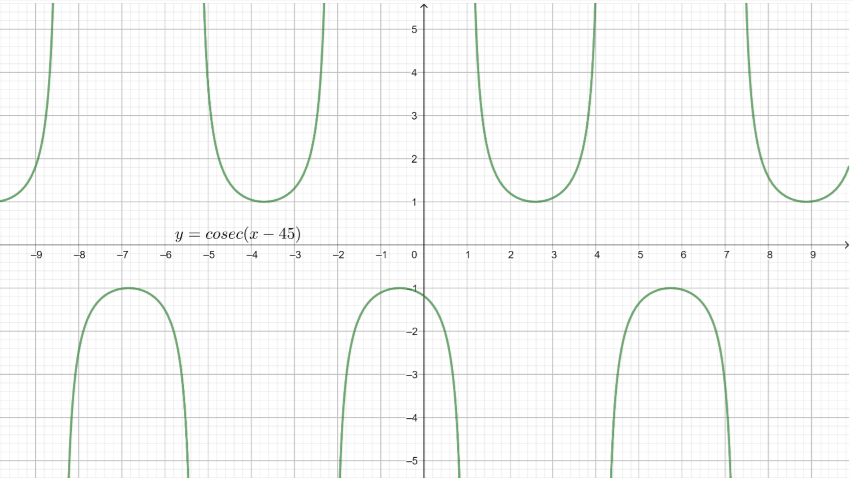
How do you graph y = csc(x – 45)?
Answer
540k+ views
Hint: Here, this problem is based on cosecant function. It is the function which is derived from basic trigonometric function i.e. sine. This equation has to be graphically represented. The angle is given in degrees i.e. 45.
Complete step-by-step solution:
Now, let’s discuss its solution.
We all are aware of the basic functions of trigonometry. They are: sine, cosine and tangent. These are the building blocks of trigonometry. When we talk about derived functions, we say secant, cosecant and cotangent. Secant is derived from cosine, cosecant is derived from sine whereas cotangent is derived from tangent. Let’s see the relationship between basic functions and derived functions.
$\Rightarrow $cosec$\theta $ = $\dfrac{1}{\sin \theta }$ or sin$\theta $ = $\dfrac{1}{\cos ec\theta }$
$\Rightarrow $sec$\theta $ = $\dfrac{1}{\cos \theta }$ or cos$\theta $ = $\dfrac{1}{sec\theta }$
$\Rightarrow $tan$\theta $ = $\dfrac{\sin \theta }{\cos \theta }$ = $\dfrac{1}{\cot \theta }$
$\Rightarrow $cot$\theta $ = $\dfrac{1}{\tan \theta }$ = $\dfrac{\cos \theta }{\sin \theta }$
Here, $\theta $ is measure of an angle in degrees or radians.
Let’s see how we can find the value of sin$\theta $ and cosec$\theta $. First draw a right angled triangle with an angle $\theta $ at C.

So,
$\Rightarrow $sin$\theta $ = $\dfrac{\text{perpendicular(P)}}{\text{hypotenuse(H)}}$
As we know that cosec$\theta $ is inverse of sin$\theta $.
$\Rightarrow $cosec$\theta $ = $\dfrac{\text{hypotenuse(H)}}{\text{perpendicular(P)}}$
Now, let’s see some even and odd functions.
$\Rightarrow $sin(-x) = -sinx
$\Rightarrow $ cos(-x) = cosx
$\Rightarrow $ tan(-x) = -tanx
$\Rightarrow $ cot(-x) = -cotx
$\Rightarrow $ cosec(-x) = -cosecx
$\Rightarrow $sec(-x) = secx
Let’s draw the graph now for the equation:
y = csc(x – 45)

Note: Do mention the equation which you represented on the graph. And do sketch it neatly. You should know the basic trigonometric functions before solving anything related to the cosecant function.
Complete step-by-step solution:
Now, let’s discuss its solution.
We all are aware of the basic functions of trigonometry. They are: sine, cosine and tangent. These are the building blocks of trigonometry. When we talk about derived functions, we say secant, cosecant and cotangent. Secant is derived from cosine, cosecant is derived from sine whereas cotangent is derived from tangent. Let’s see the relationship between basic functions and derived functions.
$\Rightarrow $cosec$\theta $ = $\dfrac{1}{\sin \theta }$ or sin$\theta $ = $\dfrac{1}{\cos ec\theta }$
$\Rightarrow $sec$\theta $ = $\dfrac{1}{\cos \theta }$ or cos$\theta $ = $\dfrac{1}{sec\theta }$
$\Rightarrow $tan$\theta $ = $\dfrac{\sin \theta }{\cos \theta }$ = $\dfrac{1}{\cot \theta }$
$\Rightarrow $cot$\theta $ = $\dfrac{1}{\tan \theta }$ = $\dfrac{\cos \theta }{\sin \theta }$
Here, $\theta $ is measure of an angle in degrees or radians.
Let’s see how we can find the value of sin$\theta $ and cosec$\theta $. First draw a right angled triangle with an angle $\theta $ at C.

So,
$\Rightarrow $sin$\theta $ = $\dfrac{\text{perpendicular(P)}}{\text{hypotenuse(H)}}$
As we know that cosec$\theta $ is inverse of sin$\theta $.
$\Rightarrow $cosec$\theta $ = $\dfrac{\text{hypotenuse(H)}}{\text{perpendicular(P)}}$
Now, let’s see some even and odd functions.
$\Rightarrow $sin(-x) = -sinx
$\Rightarrow $ cos(-x) = cosx
$\Rightarrow $ tan(-x) = -tanx
$\Rightarrow $ cot(-x) = -cotx
$\Rightarrow $ cosec(-x) = -cosecx
$\Rightarrow $sec(-x) = secx
Let’s draw the graph now for the equation:
y = csc(x – 45)

Note: Do mention the equation which you represented on the graph. And do sketch it neatly. You should know the basic trigonometric functions before solving anything related to the cosecant function.
Recently Updated Pages
A man running at a speed 5 ms is viewed in the side class 12 physics CBSE

The number of solutions in x in 02pi for which sqrt class 12 maths CBSE

State and explain Hardy Weinbergs Principle class 12 biology CBSE

Write any two methods of preparation of phenol Give class 12 chemistry CBSE

Which of the following statements is wrong a Amnion class 12 biology CBSE

Differentiate between action potential and resting class 12 biology CBSE

Trending doubts
What are the major means of transport Explain each class 12 social science CBSE

Which are the Top 10 Largest Countries of the World?

Draw a labelled sketch of the human eye class 12 physics CBSE

Explain sex determination in humans with line diag class 12 biology CBSE

Explain sex determination in humans with the help of class 12 biology CBSE

Differentiate between homogeneous and heterogeneous class 12 chemistry CBSE




